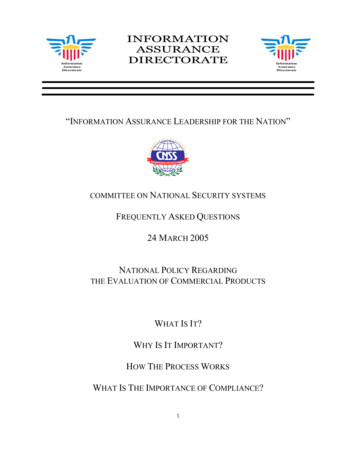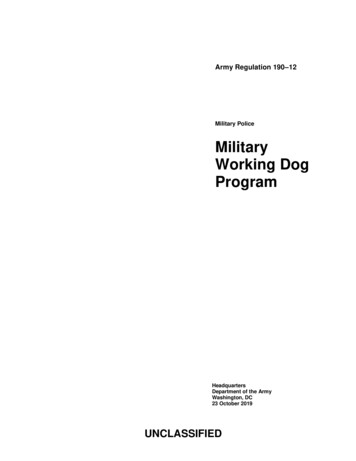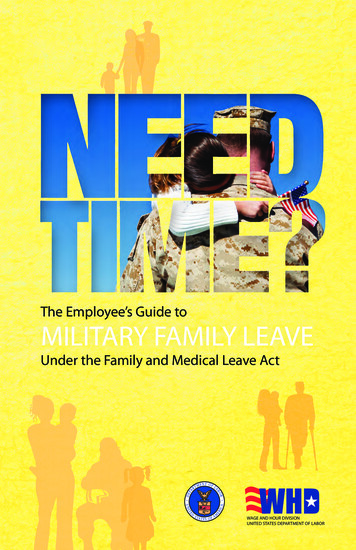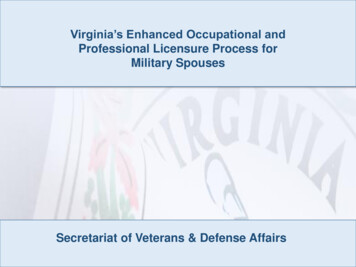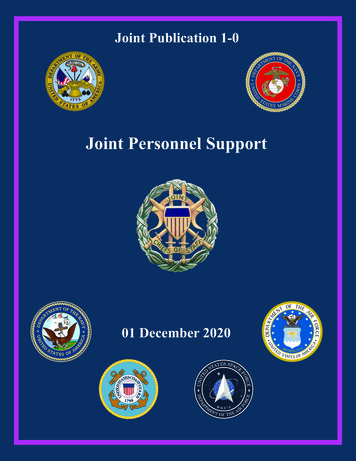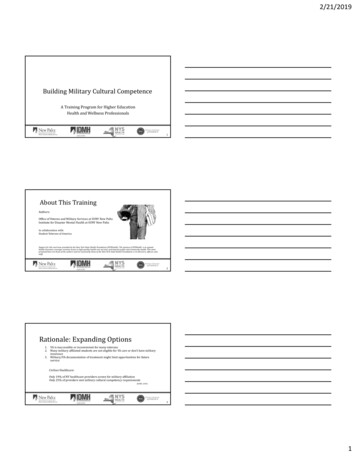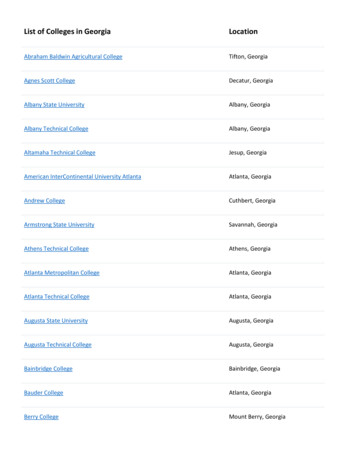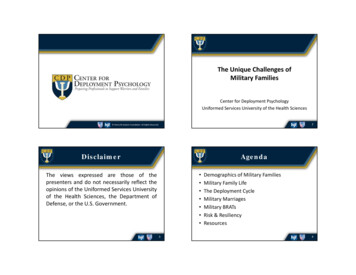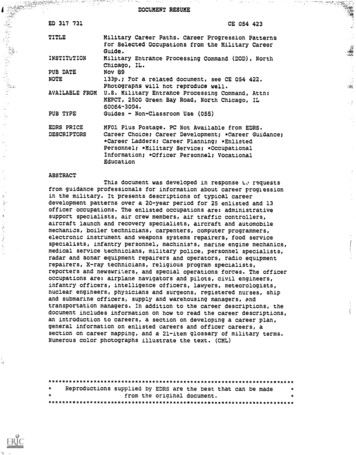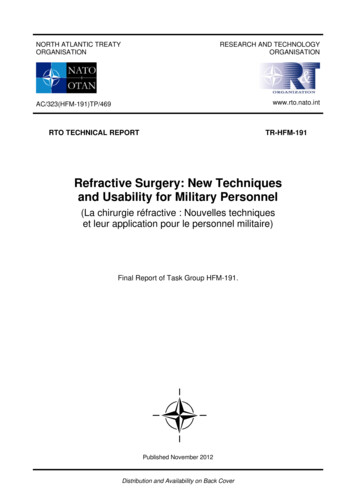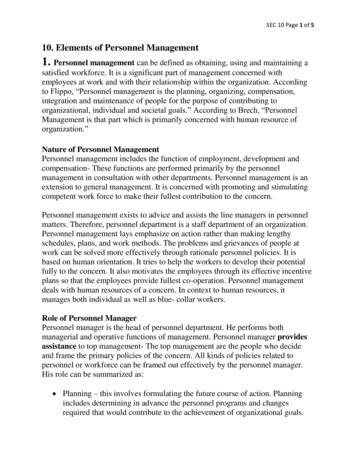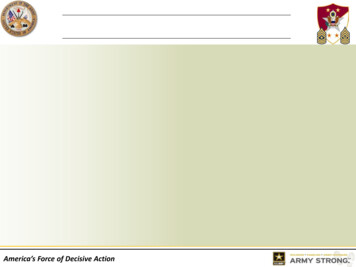
Transcription
Directorate of Military Personnel Management, DCS, G-1America’s Force of Decisive Action
Directorate of Military Personnel Management, DCS, G-1U.S. Army Training andDoctrine CommandCSM David S. Davenport Sr - TRADOC CSMCSM David O. Turnbull – CAC CSMMr. Joe B. Parson, Special Programs Division ArmyUCSM Jimmy J. Sellers – USASMA CommandantAmerica’s Force of Decisive Action2
Directorate of Military Personnel Management, DCS, G-1Evolution of NCO Education1973 U.S. Involvement in Vietnam ends (12 years)Selective Service endsTRADOC EstablishedNCOES Established with Four Levels of PMEDoctrine changes to reflect known threatTraining and Education focused on preparingfor linear fight with a known enemyAmerica’s Force of Decisive ActionToday U.S. Involvement in Afghanistan/Iraq windingdown (16 years) NCOES Evolving into NCOPDS with SixLevels of PME Doctrine changes to reflect unknowable threat Training and Education focused on preparingfor multi-domain fight with an unknown enemy
Directorate of Military Personnel Management, DCS, G-1NCO 2020 StrategyAmerica’s Force of Decisive Action4
Directorate of Military Personnel Management, DCS, G-1NCO PME BacklogThe NCOPDS Backlog willfreeze on 1 January 2016.Number of Soldiers in the Backlog4 Plus YearsBetween 3 and 4 in the Years in theBacklogBetween 2 and 3Years in theBacklogUp to 1 Year inthe BacklogBetween 1 and 2Years in theBacklogSoldiers remaining in the legacy backlogwill be given an opportunity to attendPME scheduled against existing quotasleveraging the OASS.America’s Force of Decisive ActionSoldiers over four years in the NCOPDS Backlog:TOTAL:388BLC:87ALC:193SLC:108Soldiers up to four years in the NCOPDS Backlog:TOTAL:532BLC:122ALC:251SLC:159Soldiers up to three years in the NCOPDS Backlog:TOTAL:1,165BLC:327ALC:613SLC:225Soldiers up to two years in the NCOPDS Backlog:TOTAL:1,767BLC:639ALC:757SLC:371Soldiers up to one years in the NCOPDS 4-1061-3794-56015
Directorate of Military Personnel Management, DCS, G-1Creation of the Army University1947-2010:Command and GeneralStaff College2011-2013:CAC-Leader Developmentand Education2014:CAC-Education2015-Beyond:The Army UniversityCommandCoordinationTRADOC Policy OversightPartnershipArmy University WarsLearningContinuum EducationGENDempseyWhitea CorePapers FunctionEducationArmy Learning“Optional”;Concept 2015LearningExperiencePreferred Army2014Army GeneralWhatPostureWeTeachOutcomesStatement Universal SixMajorIntermediateHowWeAreasTeachLevelEducation ArmyLeaderDevelopment FourMilestones CareerAdaptive,Creative LeadersModel ArmyLearningModel All Cohorts Faculty DevelopmentEarlier in Careers Leveraging Technology Education Across theEnterprise Education Strategy Concept Mission Command CoEAU ViceAU Vice ProvostLearningSystemsProvostAcademicAffairs1 Higher Learning Commission Master of MilitaryArt and Science Accreditation2 Joint Staff J7 Joint Professional MilitaryEducation - I Accreditation3 Associate Degree4 Joint Professional Military Education – IIAccreditation PotentialOrganization as of 07JUL15America’s Force of Decisive Action8
Directorate of Military Personnel Management, DCS, G-1Combined Arms CenterCSM David O. TurnbullCAC CSMAmerica’s Force of Decisive Action
Directorate of Military Personnel Management, DCS, G-1Army University Overview Army University “ The Why” Faculty Development and Recognition Program (FDRP) New Draft DA 1059 Army U ‘Universal” Transcript BLC- USASMA Continuing Education Degree ProgramAmerica’s Force of Decisive Action
Directorate of Military Personnel Management, DCS, G-1Army University – “Why” “The current Army Education Structure does not address thecomplexity of the 21st Century Security Environment.” The creation of Army University helps to align Total ForceOfficer, Warrant Officer, and Non-commissioned OfficerProfessional Military Education and Army Civilian EducationPrograms within a unified academic construct. Army University will increase academic rigor and relevance;increase Soldier, Army Civilian, and Leader competence,character, and commitment; expand educational prestige ofArmy learning institutions; promulgate best managementpractices; and increase institutional agility to meet the needsof the operating force.America’s Force of Decisive Action
Directorate of Military Personnel Management, DCS, G-1Faculty Development & Recognition Program FDRP expands participation from NCOs to allcohorts and components Course requirements revised to reflect the newCommon Faculty Development – Instructor Course(CFD-IC) BasicTR 600-21 scheduled publish date is 1 OCT 17Badge requirements revised and standardized toincrease instructor development and contribute tofaculty improvement and student learning. CFDP – IC (FDP 1)Local Cert Requirements (FDP 2)80 Hours as a Primary Instructor (PI)4 Developmental Observations2 Evals scoring at least 12 pntsSenior IDBC (Instr Design Basic Crs)EIC (Evaluator Inst Crs)280 Hours as a PI12 mos. as Basic Instructor3 Developmental Observations3 Evals scoring at least 16 pntsMaster TRADOC policy letter will accompany the TR 600-21publication to address the transition and recognitionof instructor time back to 10 JUL 2013 America’s Force of Decisive Action480 Hours as a PI24 mos. as Senior InstructorConduct 4 EIC evaluationsof junior Instructors3 evals scoring at least 20 pntsRecommended by Master InstructorSelection Board
Directorate of Military Personnel Management, DCS, G-1Draft DA Form 1059 Highlights GPA Includes ClassStanding (ex. #2 of157) Records APFT Score Records HT/WT Completion of aMSAF 360 evaluation Records WritingAssessment ScoreAmerica’s Force of Decisive ActionUNCLASSIFIED
Directorate of Military Personnel Management, DCS, G-1ArmyU “Universal” TranscriptJoint Transcript System:Professional Military Education-American Council on Education(ACE) CreditsCivilian Institutions:Regionally / NationallyAccredited HigherLearningCertifications:State, ca’s Force of Decisive ActionUNCLASSIFIED
Directorate of Military Personnel Management, DCS, G-1Continuing Education Degree ProgramPurpose: To leverage Academic Partner’s degree programs in order to supplement military training witheducation opportunities that drive critical and creative thinkers and provides Soldiers an academicopportunity to receive a credential within their first term of service.1. Degree program is eithertechnical or educational2. Degree program selected arealigned to technical occupationor Leadership3. Academic Institute is willing toalign learning objectives toactual courses and not justelectives.4. Academic institute providescredit for credit due and stillmaintains rigor.Professional Development ModelCredentialing PathwaysAmerica’s Force of Decisive Action
Directorate of Military Personnel Management, DCS, G-1Proponent Professional Development ModelsAmerica’s Force of Decisive Action
Directorate of Military Personnel Management, DCS, G-1Army UniversityMr. Joe ParsonCredentialing ProgramOfficerAmerica’s Force of Decisive Action
Directorate of Military Personnel Management, DCS, G-1Army Credentialing Program: StrategyIncrease Army Readiness Professionalize the Force Prepare Career Ready Soldiers! The credentialing landscape is complicated, with no “one-size, fits all” approach available! Recognition of each credential at various levels: International, National, Regional, & LocalLicensed by: Federal, State, & MunicipalityCertified by: Accredited Institution, Third-party Agency, Industry Leader, & GovernmentReciprocity among: States, Locality, Occupational Fields, & EmployersCredentialing support requirements: Administrative, Training Materials, Training Provider, Certification/License,Recertification/Licensing & Continuing Education Units (CEUs)America’s Force of Decisive Action
Directorate of Military Personnel Management, DCS, G-1Army Credentialing ProgramAmerica’s Force of Decisive Action
Directorate of Military Personnel Management, DCS, G-1Army Credentialing Program:Credentialing Inclusion SimplifiedAmerica’s Force of Decisive Action
Directorate of Military Personnel Management, DCS, G-1United States ArmySergeants MajorAcademyCSM Jimmy J. SellersCommandantAmerica’s Force of Decisive Action
Directorate of Military Personnel Management, DCS, G-1Agenda PurposeProblem StatementLeader Core Competencies (LCC) aka Common CoreWhy and How of NCO PME Redesign/StrategyBasic Leader CourseMaster Leader CourseDistributed Leader Course (DLC) aka SSDSergeants Major Course with Bachelors Degree ProgramITCOPQuestionsAmerica’s Force of Decisive Action
Directorate of Military Personnel Management, DCS, G-1PurposeTo present an update of the NCO Professional MilitaryEducation, Leader Core Competencies (LCC) across thelearning continuum.America’s Force of Decisive Action
Directorate of Military Personnel Management, DCS, G-1NCO PME Problem StatementProblem: Lack of a unified and relevant standardized corecompetencies in NCO PME. Current curriculum fails to meetthe Army’s needs of leader competencies across the NCOcohort.America’s Force of Decisive Action
Directorate of Military Personnel Management, DCS, G-1Leader Core Competencies (LCC)TRADOC has determined that there are six LeaderCore Competencies (LCC), formally known asCommon Core, that all NCOs should develop whilein PME: America’s Force of Decisive ActionReadinessLeadershipTraining ManagementArmy and Joint OperationsProgram ManagementCommunications
Directorate of Military Personnel Management, DCS, G-1What We Did USASMA conducted Analysis:– Needs, Goal, Target Audience, and Gap Analysis How:– Surveyed target audiences (E-1 to O-4) on topics, and conductedsubject matter expert (SME) discussions with Soldiers and leaders(TRADOC, FORSCOM, & IMCOM) from all 3 compos Where:-Fort BenningFort GordonFort Leonard WoodFort HuachucaFort LeeFort BlissAmerica’s Force of Decisive Action- Fort Rucker- Fort Sill- Fort Knox- Camp Williams, Utah- Fort Jackson- Ft. Bragg
Directorate of Military Personnel Management, DCS, G-1Considerations Considered all data points (Surveys, Previous CTSSBs, Directives, validationreports, focus groups, site visits to COEs, etc.) TRADOC CSM’s 6 LCCs (Readiness, Leadership, Training Management,Communications, Program Management, Army and Joint Operations) Supports the Army Operating Concept’s (20) Warfighting Challenges Supports 4 Army Learning Areas and 14 General Learning Outcomes Bloom’s Taxonomy (content at the appropriate learning level & domain) All lessons written in the Experiential Learning Model (ELM) Format Supports NCO 2020 Strategy & ALDS IAW The Army Learning Concept 2020-2040America’s Force of Decisive Action
Directorate of Military Personnel Management, DCS, G-1What was confirmed Deficiencies in Communications, Leadership, Operations (Army & Joint),Program Management, Readiness, and Training Management (Six leadercompetency areas) Lack of integration and synchronization of the Army Learning Areas(ALA), and the General Learning Outcomes (GLO) in accordance withTRADOC Pam 525-8-2, The U.S. Army Learning Concept for Training andEducation 2020-2040 Courses currently do not focus on problem-based assessments, promotecritical or creative thinking, nor are they learner centric Courses are not sequential or progressiveAmerica’s Force of Decisive Action
Directorate of Military Personnel Management, DCS, G-1CURRENT NCO PME LEARNING CONTINUUMNo Armystandard for ALCor SLC DMLCSMCMasterLeaderCourseSergeantsMajorCourseSSD Level ISSD Level IISSD Level IIISSD Level IVSSD Level V80 Hours73.1 Hours80 Hours76 Hours80 HoursPME not sequential or progressive and SSDs do not support school curriculumAmerica’s Force of Decisive Action
Directorate of Military Personnel Management, DCS, G-1FUTURE NCO PME LEARNING CONTINUUMStandardizedLeader CoreCompetencies inALC & SLCIETDLCDLCFOCFY eSeniorLeaderCourseDLC Level IDLC Level IIDLC Level geantsMajorCourseDLC Level IV DLC Level V DLC Level VIEach level of DLC will be approximately 40 hoursAll PME is sequential and progressive and DLC supports resident curriculumAmerica’s Force of Decisive Action
Directorate of Military Personnel Management, DCS, G-1Strategy Increased rigor in content with written assessments that requires moreresearch (no multiple choice exams) Content will have more practical application Assessments will be based on demonstrated abilities and learning outcomes Content will be sequential and progressive across the continuum Focus will be on leader competencies and attributes Built under the Experiential Learning Model (ELM) for adult learning Is learner centric & facilitated, not lecturedAmerica’s Force of Decisive Action
Directorate of Military Personnel Management, DCS, G-1Basic Leader Course - Current 22 Days, 169 hours Current BLC has 3 Modules:- Leadership, 49 hours- Training Management, 41 hours- Warfighting, 79 hours Current BLC has 30 Lessons, 9 evaluations/assessmentsand 3 multiple choice examinationsAmerica’s Force of Decisive Action
Directorate of Military Personnel Management, DCS, G-1Basic Leader Course - New 22 Days, 169 hours The new BLC is designed in the LCCs:- Readiness, 37 hours- Leadership, 42 hours- Training Management, 22 hours- Operations, 14 hours- Communication, 47 hours- Program Management, 7 hours New BLC has 22 Lessons, 5 evaluations/assessments andno multiple choice examinationsAmerica’s Force of Decisive Action
Directorate of Military Personnel Management, DCS, G-1Master Leader Course 13 Straight days, 112 hours 4 Modules: Communications 22 hours, Leadership &Management 14 hours, Operations 76 hours 10 NCOA Locations: Ft. Dix, Ft. Knox, Ft. Bragg, Ft.Bliss, Ft. Campbell, JBLM, Ft. Hood, Ft. Stewart,Camp Williams, Camp Shelby Operationally focused education Academically rigorous with an emphasis on adaptivethinking and collaborative problem solving Non resident version projected to be FOC May 18America’s Force of Decisive Action
Directorate of Military Personnel Management, DCS, G-1MLC Outcomes (Student Comments) “One of the best courses I’ve ever attended” “I feel way more confident working on a staff now” “I got the most out of the MDMP and Joint lessons” “This is the stuff I’ve been wanting from other schools, but didn’tget” “This course was extremely (academically) challenging. I reallylearned a lot” “Is the Army willing to invest in NCO education? We need moretime to reflect and absorb the mass amounts of this greatinformation”America’s Force of Decisive Action
Directorate of Military Personnel Management, DCS, G-1Distributed Leader Course - DLC SSDs will undergo a name change to Distributed Leader Course (DLC) andwill consist of six levels designed and developed with a more modern lookand feel that today’s Soldiers identify with Soldiers are auto-enrolled upon completion of IMT and each NCO PMEcourse. Working to change auto-enrollment upon Soldier being eligible forpromotion Once enrolled, must complete DLC prior to attending PME based onpromotion eligibility Designed using the Experiential Learning Model (ELM) of Adult Learning DLC I to be delivered to the force 1 June 2018 and each level after onaverage of 4 monthsAll PME is sequential and progressive and DLC supports resident curriculumAmerica’s Force of Decisive Action
Directorate of Military Personnel Management, DCS, G-1Distributed Leader Course - DLCAmerica’s Force of Decisive Action
Directorate of Military Personnel Management, DCS, G-1Distributed Leader Course - DLCAmerica’s Force of Decisive Action
Directorate of Military Personnel Management, DCS, G-1Distributed Leader Course - DLCAmerica’s Force of Decisive Action
Directorate of Military Personnel Management, DCS, G-1Resident SMC 69 Proposed Course MapAmerica’s Force of Decisive Action60dsDepartmentDepartment ofofof nt (DPD)Studies(DPS)Leadership(DCL)CSM/SGM Broadening Subjects(All Students Participate)Certificates & Credentialing(Student’s Option)College(Student’s Option)SMC Electives(Student’s Option)1d8dsGraduation & Out Processing1d 5dsCapstone, E-Portfolio, IDP, and Counseling(DFM)30dsSpring Block LeaveDepartmentof ForceManagement9ds 1dCapstone, E-Portfolio, IDP, and Counseling(DMO)Joint andArmy Operations30dsCapstone, E-Portfolio, IDP, and CounselingDepartment ofMilitaryOperations1dDecember Block Leave60dsCapstone, E-Portfolio, IDP, and CounselingIn ProcessingFoundations5ds 6ds
Directorate of Military Personnel Management, DCS, G-1Institutional TrainingCommon Operational Picture (ITCOP) Who: Institutional Training Common Operational Picture (ITCOP) provides a snapshotof all NCOA and MOS-T courses available to all Soldiers regardless of componentaffiliation. What : An ATRRS-managed tool that provides commanders and leaders an up-to-datestatus of training through multiple dashboards -- the open seat dashboard, the fill ratedashboard and the school fill rate dashboard. Where: ATRRS home page at: https://www.atrrs.army.mil/ITCOP When: The ITCOP provides the ability to view available institutional training seats from0-120 days of a class start date by military occupational specialty, career managementfield and location. Why: The ITCOP is a one-stop program that enables commanders and leaders toefficiently monitor TASS capacity vacancies in near real-time and capitalize onopportunities to schedule Soldiers for training as needed -- to maximize trainingexecution in a resource-constrained environment. .America’s Force of Decisive Action42
Directorate of Military Personnel Management, DCS, G-1Institutional TrainingCommon Operational Picture (ITCOP)America’s Force of Decisive Action43
Directorate of Military Personnel Management, DCS, G-1Questions?End State: NCO PME Courses that are relevant,synchronized, progressive and integrates coreleader competencies across the continuum.America’s Force of Decisive Action
Leader Core Competencies in ALC & SLC . BA Degree . DLC Level VI. IET. NLC. Each level of DLC will be approximately 40 hours. DLC. DLC. DLC. DLC. DLC. DLC. Directorate of Military Personnel Management, DCS, G -1 America's Force of Decisive Action Strategy Increased rigor in content with written assessments that requires more
